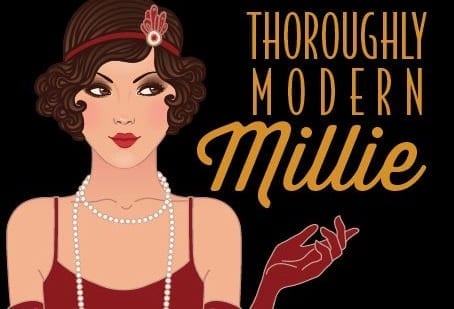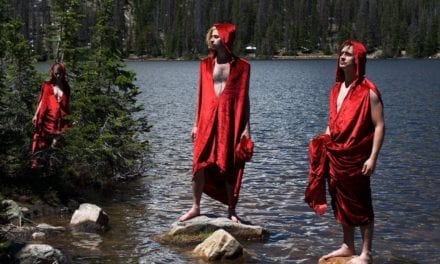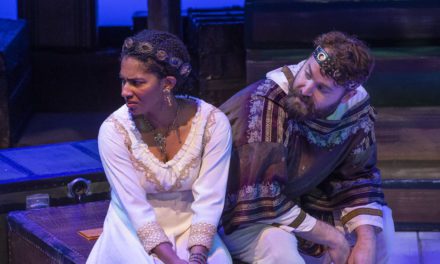SANDY — This is the 35th year of A Christmas Carol at Hale Centre Theatre, a venerable and cherished tradition (which is not included in season tickets). It begins with a lengthy voice-over imploring patrons to order 2020 season tickets, snatch up tickets to Seussical, and generously donate to the theater. Considering the season and subject matter, encouraging patrons to donate to the needy might be more in order, but I digress.

Show closes December 26, 2019.
Once the show begins, Mr. Dickens (portrayed by Adam Dietlin) welcomes the audience before morphing into the role of Fred. According to the dialogue written by Melany M. Wilkins and Richard G. Wilkins, Dickens saw himself as Fred, so it was natural he would assume the role. The title role is played by David Weekes, who gave a robust performance as Scrooge.
Instead of original songs, the production’s musical score (by Barlow Bradford) weaves in traditional carols like, “What Child is This?,” “Bring a Torch, Jeannette Isabella,” and “Good Christian Men Rejoice.” One nice touch is that the primary instrument, a fiddle, was played onstage by an in-character musician (Katie Frandsen).
Knowing the vast resources of Hale and the extreme lengths they often go to for props and special effects (it’s not unusual to see cars, planes, and even eye-poppingly realistic elephants galumph across the stage), I eagerly anticipated how they’d transform Scrooge’s doorknocker in an early scene. Imagine my disappointment when it was just another projection like every community production in history.
Otherwise, sets by Kacey Udy were up to his usual high standards. Integrating a clock into the design was functional and gave a London-esque feel to the play. One thing I realized about Udy’s work from this production is how good he is at filling the surprisingly high proscenium arch of the Jewel Box stage. Notice how Scrooge’s office towers with ancient tomes and how the Cratchit hovel goes up and up and up, culminating in a sad tiny bed. The “rag and bottle shop” was also likely the most lovingly designed pawnshop in Utah theater history.
This dialogue-rich version and expands several scenes and characters beyond what audiences may be used to. Belle (Lauren Von Forell) has aplenty to say, and scenes like the Cratchit home and pawnshop are considerably fleshed out. The script itself was quite good and contained a lot of humor, much of which unfortunately didn’t land, which seems to often be the case at Hale. An audience an contribute to how the humor lands, of course, but in this case, the actors are more culpable than usual.
While everyone onstage displayed talent as a capable singer and actor, they seemed rushed throughout and often didn’t take the time and care necessary to express the script. This rushed feeling was particularly evident in the pawnshop scene and when Scrooge awakens a changed man. In both scenes, the actors laughed and laughed, but it was unclear what they were laughing at.
I suspect one of the reasons for the lack of crispness and clarity was the insane performance schedule. The Saturday cast performs four times (with only a half-hour break between), so it’s no surprise that spark and coherence weren’t at optimal levels. Asking non-professional actors to do a quadruple booking certainly smacks of some Scrooge-level avarice on the theater’s part.
The cast also had to cover a couple issues with props and sets. In the first scene, teenage Scrooge couldn’t retrieve a broom, and it caused him to miss a mark. Later on, the stage didn’t rotate properly and left Scrooge’s office on a diagonal. Perhaps these issues also resulted from an overbooked crew. Fortunately for the show, the actors covered both these misfortunes well, and Weekes was particularly good at ad-libbing lines as he moved his office into place.
Sound design by Dan Morgan was a strong point. The audio was clear and well-mixed, and the quality of mics was superb. The hellish distortion on Marley’s Ghost (played by Matt Kohler) was excellent and added a fresh, demonic slant on the scene.
In addition to improvements that could be made to delivery, this production (directed by John Sweeney) simply didn’t seem to have as much life as other local theaters’ productions. In CenterPoint Theatre’s 2017 version, instead of just appearing, the Ghost of Christmas Present entered the stage on a swing—a perfect entrance for a joyful character. And the zombie masquerade they cooked up for Marley’s scene was dazzling and exciting and left a stunning impression.
Last year, I was transfixed and delighted by The Grand Theatre’s operatic version of A Christmas Carol. It was so good, I was convinced Dickens was always meant to be an operetta. The Grand is doing the show again this year, and I strongly recommend it over the Hale’s production (especially because the Hale’s production is practically sold out). While not every production of A Christmas Carol needs to be full of song and dance numbers, Hale’s version was simply not as entertaining as its rival versions. The Grand’s production runs December 5-7 and is definitely worthy of your merry patronage.

This review generously sponsored by a grant from the Salt Lake County Zoo, Arts, and Parks program.





